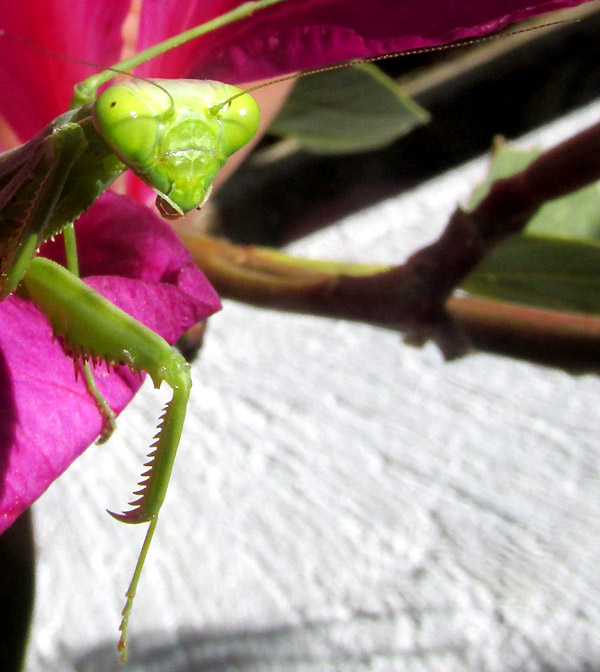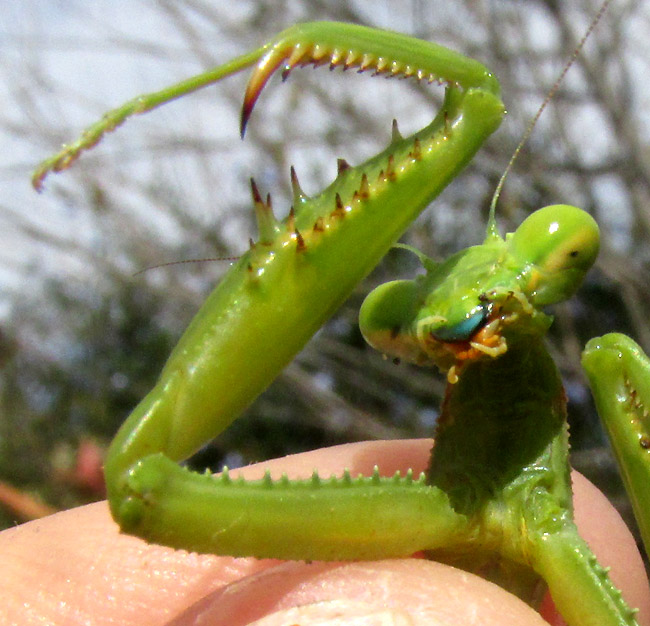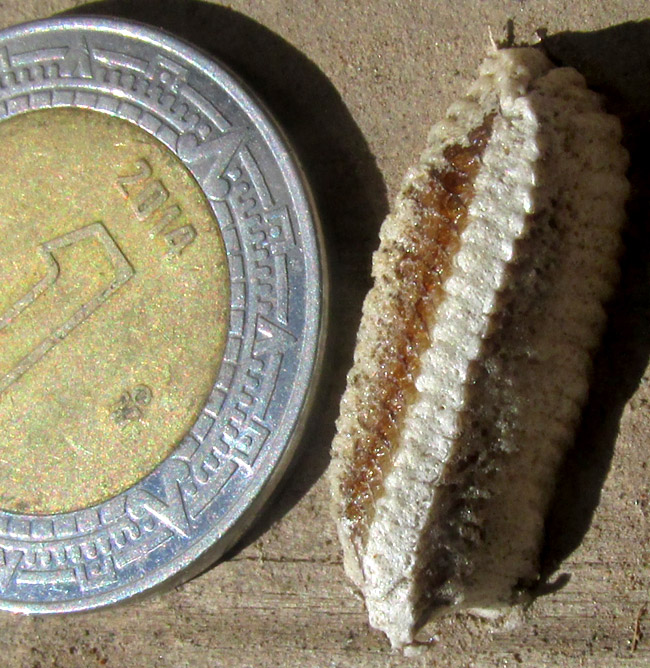Excerpts from Jim Conrad's
Naturalist Newsletter
Entry dated January 1, 2024, issued from near Tequisquiapan; elevation about 1,900m, (6200 ft), ~N20.57°, ~W99.89°; Querétaro state, MÉXICO
BORDERED MANTIS

In the walled-in backyard of a house at the edge of a small village surrounded by semiarid scrub, for a couple of weeks the above mantis has been on and around a certain branch of a flowering Purple Orchid Tree hybrid. At first I didn't consider closely studying the visitor, assuming it was the same species I often watched as a child in Kentucky, and already would be abundantly documented on the Internet. However, eventually I remembered that very similar invasive species exist, and I wondered whether this might be one of those. For example, there's the Chinese Mantis.
However, BugGuide.Net's page for that species says that the Chinese Mantis facial shield -- the plate between the eyes and below where the antennae arise -- is relatively squarish compared to that of the Carolina Mantis, which I'd assumed our mantis to be. Here's our mantis's face with no squarish facial shield.

Also, there was the European Mantis. BugGuide.Net's page for that species said that black-ringed spots on the front coxae distinguish this species from all other North American mantids. In entomology, the coxa is the first, or basal, segment of the insect leg. These black-ringed spots are very conspicuous, but they're on the inside of the front legs, not visible when the mantis holds its legs together. It was easy to catch our mantis for a good look at the open coxae:

As you can see above, there's no hint of black-ringed spots inside the front coxae. Also, notice our mantis's bluish upper lip. In the end, our mantis was so similar to the Carolina Mantis, which does occur in this area, that the blue upper lip became the decisive feature.
Finishing taking the above photos, I noticed that beside the tree, on a wooden platform holding potted plants, a mantis egg case recently had appeared, surely deposited there by our mantis:

The egg case, or ootheca, is next to a Mexican one peso coin, which is 21mm (~13/16inch) in diameter. The egg case seems a little more angular than that of the Carolina Mantis.
BugGuide.Net helped in assigning our mantis to the genus Stagmomantis. The GBIF website indicated that currently Stagmomantis comprises 32 species native to most of the US south at least to northern South America. Also, in our part of upland central Mexico, Stagmomantis carolina, with no blue upper lip, has been documented, but STAGMOMANTIS LIMBATA, which does display a blue upper lip, overwhelmingly is more commonly observed.
Stagmomantis limbata often is called the Bordered Mantis, and in the US the Arizona Mantis or New Mexico Praying Mantis. However, it's distributed well beyond the southwestern US, south throughout Mexico to Honduras and El Salvador. Reaching up to around 7.6cm (3inches) in length, it's known as one of the largest mantids native to North America. It occurs in varied habitats, from towns and roadsides to wooded areas along streams, canyons and more.
BugGuide.Net tells us that females usually are plain green, while males normally are green and brown, though in both sexes there's variability. In females, the blueness of the upper lip is more pronounced than in males. Males are slender, while females develop plump abdomens. Our mantis surely is a female. Females don't fly, which may explain why ours has remained on the same branch for so long, and why she was easy to catch. Males often gather around nightlights in numbers. In colder areas Bordered Mantises overwinter as eggs, though sometimes, especially females, survive well into winter.
Bordered Mantises, as with other large mantis species, are regarded as beneficial to gardeners because they prey on other insects which may damage garden plants. They also eat one another. Michael Maxwell and Caylin Frinchaboy in the 2014 study "Consequences of Intraspecific Variation in Female Body Size in Stagmomantis limbata (Mantodea: Mantidae): Feeding Ecology, Male Attraction, and Egg Production," reported seeing female Stagmomantis limbata cannibalizing males, as well as other females.
Joe Ballenger at the AskEntomologists.Com website, speaking about mantis cannibalism in general, says that during the mantis mating process the male may be eaten by the female about 20-30% of the time. The males seem to recognize the danger and not like the idea; they approach the females very cautiously, especially slender females who move the fastest. Females who eat their male partners produce more eggs, but the cannibalism isn't necessary for reproduction.
In Marty Crump's 2005 book Headless Males Make Great Lovers and Other Unusual Natural Histories, it's explained that often sex takes place after the female already has eaten the male's head. He writes, "... the headless wonder swings his legs around until his body touches hers, climbs onto her back, and copulates as though nothing were amiss." This is made possible because copulatory movements in mantids are controlled by nerve tissue in the abdomen, not in the brain. Males in some mantis species actually mate more effectively when decapitated. That's because decapitation removes a nerve which inhibits mating until the female is clasped; and when the nerve is removed, the result in repeated copulation, robot-like.